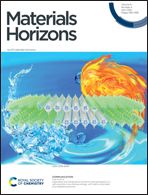Spatially isolated redox processes enabled by ambipolar charge transport in multi-walled carbon nanotube mats†
Abstract
This work demonstrates a simple dual-well device which enables spatially isolated solutions to undergo complementary redox reactions. The device functions by the ambipolar transport of charge carriers between two spatially isolated poly(dimethylsiloxane) (PDMS) microwells through an underlying multi-walled carbon nanotube (MWCNT) mat. This MWCNT mat enables charge carriers, produced from the decomposition of an analyte in one solution, to drive a redox reaction in a spatially isolated second colorimetric read-out solution via a potential difference between the wells. As proof-of-concept a visible colorimetric read-out was shown using an enzyme, cytochrome c (reduced in 16 h), and the visualizing reagent 3,3′,5,5′-tetramethylbenzidine (TMB) (oxidized in 2.5 h) for the detection of dithionite and hydrogen peroxide, respectively, without any external energy input. We discuss the origin of this phenomenon and highlight the ability of MWCNTs to accept and transport both electrons and holes efficiently between spatially isolated solutions giving rise to a highly versatile sensor suitable for use in simple, low-cost point-of-care diagnostics.



 Please wait while we load your content...
Please wait while we load your content...